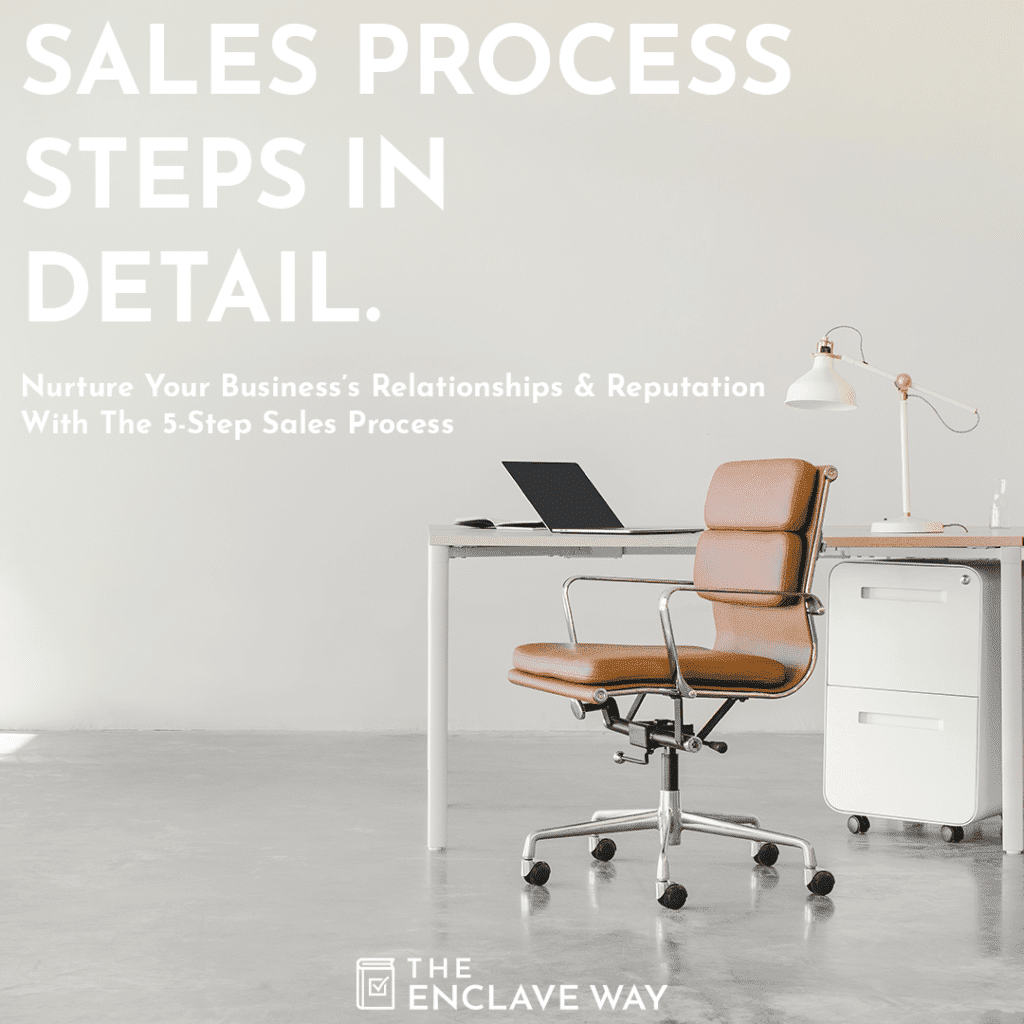Nurture Your Business’s Relationships and Reputation With
THE 5-STEP SALES PROCESS
Today it’s estimated that we are exposed to between 6,000 and 10,000 ads daily.
Obviously, that’s much more than the number of daily purchases we make. So where’s the gap?
A general rule in advertising is that a person needs to see an ad about seven times before even noticing it.
What does this say about consumers’ spending habits?
Sales Process Steps
In our last post, we talked about the foundational steps to take before trying to sell to a client.
This week, we’ll break down each of the five steps in the sales process. We’ll dig deeper to see the benefit of focusing on lead measures – the controllable, influenceable steps leading up to the desired outcome – instead of skipping straight to selling
1. Rapport
Gaining quick rapport with clients is crucial if you want business to continue with a client. One of the reasons The Enclave Way talks so much about “saving the human side of business” is because the need for relationships is timeless.
Money represents how a person has spent her time. That means a lot of care goes into deciding how that money is spent.
If a person is to be separated from her money, she needs to trust the person leading her toward that sale.
Rapport comes from making a positive connection with someone right away. This means upholding her as an individual worth your attention.
Through our coaching and courses, The Enclave Way suggests finding a personal point of connection within the first 30 seconds of meeting with a new client. This can be as simple as a compliment or as intentional as connecting on a commonality you’ve previously researched.
Building rapport successfully should be done purposefully. Once the professional relationship is established, there will be trust that leads to clear and open communication.
2. Needs Analysis
“The customer is always right” is a saying to keep in mind when approaching the step of analyzing needs.
Now that good rapport is established, the client’s needs must be heard and prioritized. This can be done in many ways including:
- Asking great questions
- Listening sincerely
- Studying any material and requests the client provides
- Determining wants, needs, and where there’s room to compromise
- Researching great value
The mistake would be to skip right to selling before having a good understanding of the client’s desires.
3. Identify Critical Issues
Identifying critical issues is when all involved parties prioritize the Needs Analysis. These are the most important things your client needs.
This step can only be done well if step two – Needs Analysis – was done thoroughly.
Here it is essential to have everyone on the same page and in full agreement. If that isn’t happening, you’ll need to go back and dig deeper into the Needs Analysis by asking better questions.
4. Connect to Products and Services
Mismatching a client with products and services indicates a miscommunication or ignorance of the previous steps.
By connecting a client to appropriate products and services, a salesperson demonstrates the client’s importance and value. The client feels heard and can see she is respected and understood.
At this point, the salesperson can confidently present options to the client, knowing they agree on the critical issues. The salesperson is the key that connects the client with value.
5. Pre-Close Close
Through the dance of the Pre-Close Close, the salesperson works through hesitancies and objections with the client.
Jumping straight into the close risks appearing aggressive and causing the client to back off, thus losing the sale.
To avoid this, the salesperson’s job is to clearly and professionally negotiate through any objections before closing the deal. In doing so, the salesperson again demonstrates respect for the client.
Clear communication is crucial every step of the way. This is what maintains the trust that was gained at the beginning of the process.
The Magic is in the Process
So back to our question at the beginning: What can we tell about consumers’ spending habits based on the need to see an ad an average of seven times before interacting with or purchasing from that brand?
Consumers and clients need to build up an understanding and relationship with an organization before deciding on it.
And that’s where the 5-Step Sales Process comes in. Behind every good salesperson is this process, customized to fit the situation and the client.
This process has helped:
- Interviewees land competitive jobs
- Agents win million-dollar listings
- Businesses gain clients
- Family members make deals with each other
- So much more
Bring consistency and intentionality to your approach with clients. This sales process will help you grow a business that’s salable, scalable, and duplicatable.

